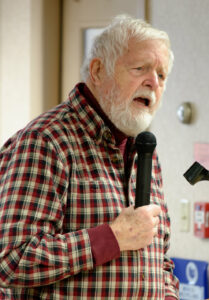At our Thursday, February 22 club meeting, Steve Taylor, Local Historian spoke to the club.
 Steve Taylor is a farmer, newspaperman, and longtime public official. He served as commissioner for agriculture in New Hampshire. He has studied, written, and spoken for many years about New Hampshire’s rural culture and the state’s agricultural history. With his three sons, he operates a livestock and maple farm in Meriden Village. He has been a newspaper reporter and editor and was founding executive director of the New Hampshire Humanities Council. He served 25 was the state’s commissioner of agriculture.
Steve Taylor is a farmer, newspaperman, and longtime public official. He served as commissioner for agriculture in New Hampshire. He has studied, written, and spoken for many years about New Hampshire’s rural culture and the state’s agricultural history. With his three sons, he operates a livestock and maple farm in Meriden Village. He has been a newspaper reporter and editor and was founding executive director of the New Hampshire Humanities Council. He served 25 was the state’s commissioner of agriculture.Steve reflected on being a lifelong resident of NH and the environmental changes he has witness in the Upper Valley and in New Hampshire.
He talked about open pastures/forest; rivers and brooks; dumps to landfills; wildlife changes, land investments and social capital.
- Open Land vs Forest: He started his talk sharing that in the 1920s, 80% of the land was open pasture and 20% was forest. The percentages have now reversed. If mother nature had her way, she would return the state to full forest. It is Steve’s hope that open pastures will remain in New Hampshire as they permit us to see beautiful vistas that surround us.
- Rivers and Brooks: As a child he was always reminded that he should never swim in the brooks and rivers as they were filled with industrial waste and human waste. The goal was to stay as far away from rivers and brooks as was possible. With the clean water act in the 1970s, investments have been made to clean our waterways. As a child he never would have believed that our waterways would become recreational resources enjoyed by many.
- Dumps to Landfills: As a child, open burning was the way a lot of our garbage was managed. It was never pleasant to be downstream of the fires coming from the “dump”. Je talked about the huge rats that lived in the variety of household and other waste. We now have recycling centers and well managed landfills/solid waste facilities.
- Wildlife Changes: Coyotes are now back in New Hampshire. Although they can be know for killing poultry and pets, they also help keep other populations of animals in check. Turkeys have been reintroduced. This happened in the 1970s. Turkeys love dairy farms as cows excrete a lot of undigested grains and are eaten by turkeys. Beavers had been trapped and shot into extinction. They were reintroduced in 1905. They are tenacious builders. You can breach a dam they have built and in a matter of days they will reconstruct it. Moose are back but not in large numbers. He shared a story about an albino moose that lived in the Methodist Hill area. Black bears are back and scrounge garbage and bird seed that often are too available due to human carelessness. He talked about deers, too many; rabbits (snowshoe and cottontail); possums, fierce fighters, that he he really doesn’t enjoy; turkey vulchers that that clean a carcass, like a cow, down to the bones quickly; wild boar,there is an “open season” on wild boars; and Eagles.
- Land Investment: Steve ended his talk talking about the escalating cost of land. He talked about a period of time when land in the Upper Valley could sell at $10/acre. Peany Goodwin took advantage of this and helped him make a fortune. As we know know, land can sell for thousands of dollars.
- Social Capital; He spent a few minutes reminding us how both Television and computers and cellphones have impeded individuals from coming together to socialize. All can keep us apart and distant from one another.

Recent Comments